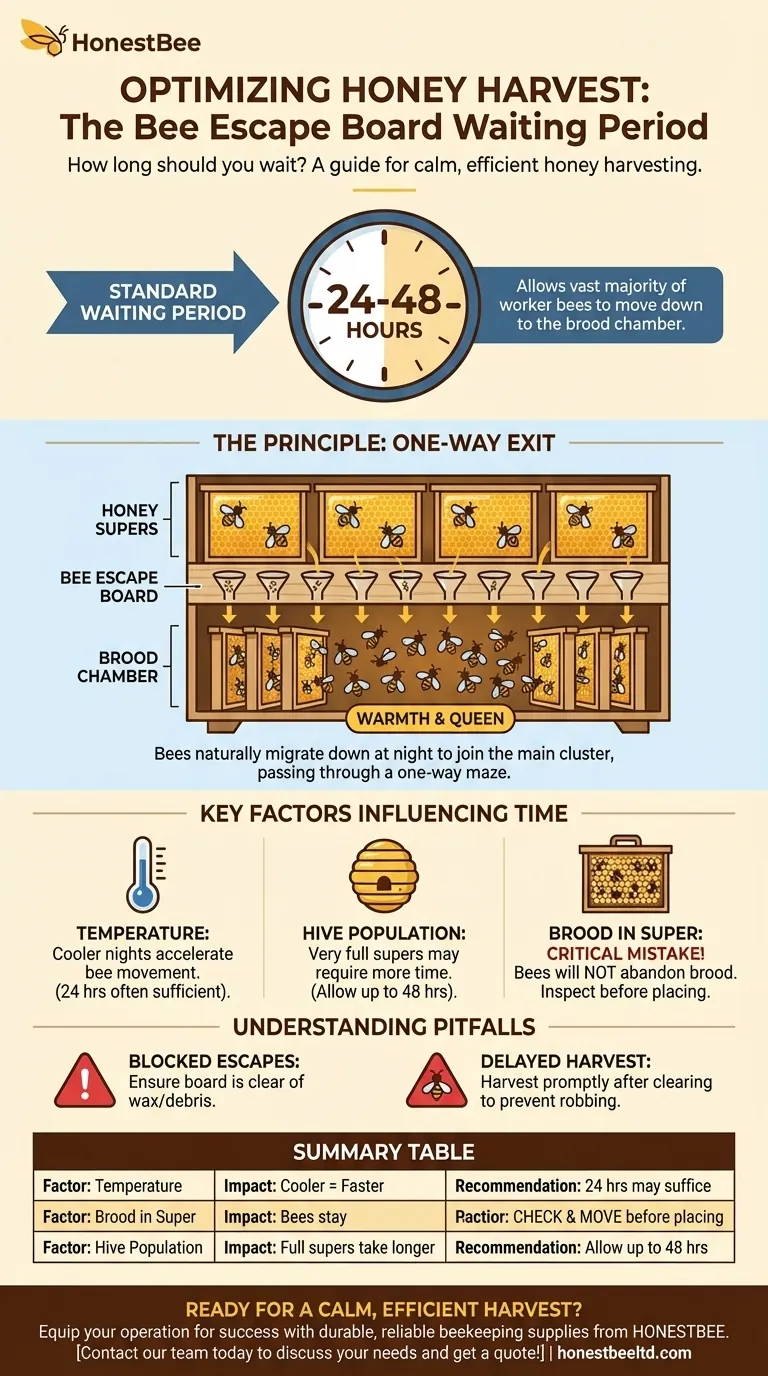The standard waiting period after placing a bee escape board is between 24 and 48 hours. This allows the vast majority of worker bees in the honey supers to move down into the brood chamber, leaving the frames nearly empty and ready for a calm, efficient harvest.
A bee escape board is a tool of patience. While 24 hours is the benchmark, factors like temperature and the state of your hive mean a 24 to 48-hour window is the most reliable guideline for ensuring a bee-free super.

How a Bee Escape Board Simplifies Your Harvest
A bee escape board is fundamentally a one-way door for bees, designed to clear your honey supers with minimal stress for both you and the colony.
The Principle of the One-Way Exit
The board contains a small maze or funnel system. Bees can easily navigate it from the honey super down into the brood chamber below, following their natural instincts.
However, the design makes it extremely difficult for them to find their way back up into the super. Over time, this one-way traffic systematically empties the supers of bees.
Why Bees Move Downward
Bees are driven by a powerful instinct to remain with the main cluster and the queen, especially as temperatures drop overnight.
The escape board leverages this behavior. As evening approaches, bees in the upper supers will naturally migrate downward to join the warmer, more populated brood nest, passing through the escape board on their way.
Optimizing Your Timing: Key Factors to Consider
While 24-48 hours is the rule, understanding the variables allows you to fine-tune your timing for maximum effectiveness.
The 24-Hour Rule of Thumb
For most hives in typical conditions, 24 hours is sufficient to clear over 95% of the bees from a super. This is the most commonly cited timeframe and a reliable starting point.
The Impact of Temperature
Cooler nights are your best ally. A significant drop in nighttime temperature strongly encourages bees to move down into the brood chamber for warmth, accelerating the clearing process.
If temperatures remain high overnight, bees may be less motivated to move down, potentially requiring you to wait longer than 24 hours.
The 48-Hour Safety Window
Leaving the board on for up to 48 hours provides a buffer for less-than-ideal conditions, such as warm weather or an exceptionally populated super. This extended period ensures even the most stubborn bees have time to migrate down.
Understanding the Trade-offs and Common Pitfalls
Using a bee escape board is highly effective, but success depends on avoiding a few critical mistakes.
The "Brood in the Super" Mistake
A bee escape board will fail if there is any brood (eggs, larvae, or pupae) in the honey supers you are trying to clear. Nurse bees will not abandon the brood, rendering the one-way exit useless.
Always inspect your supers for brood before placing the escape board. If you find any, that frame must be moved down into the brood chamber.
Blocked or Damaged Escapes
Before installation, ensure your escape board is clear of debris, wax, or propolis. A blocked exit prevents the bees from leaving, defeating the entire purpose of the device.
Prompt Harvesting is Crucial
Once the supers are clear of bees, they are defenseless against robbing from other hives or pests. You should plan to harvest the honey promptly after the 24-48 hour waiting period to prevent your hard work from being stolen.
Making the Right Call for Your Harvest
Use these guidelines to decide on the optimal waiting period for your specific situation.
- If your primary focus is speed with ideal conditions (cool nights, no brood): A 24-hour waiting period is almost always sufficient.
- If you are facing warmer weather or have very full supers: Plan for a 36 to 48-hour window to ensure the supers are fully cleared.
- If your priority is avoiding mistakes: Always inspect for brood in the honey supers before you even consider placing the escape board.
Mastering the use of a bee escape board transforms your harvest from a disruptive chore into a calm and rewarding process.
Summary Table:
| Factor | Impact on Waiting Time | Recommendation |
|---|---|---|
| Temperature | Cooler nights accelerate bee movement. | 24 hours may suffice. |
| Brood in Super | Bees will not abandon brood. | Check and move frames before placing the board. |
| Hive Population | Very full supers may take longer. | Allow up to 48 hours for a safety buffer. |
Ready for a Calm, Efficient Harvest?
Mastering your harvest starts with the right equipment. At HONESTBEE, we supply durable, reliable beekeeping supplies and equipment to commercial apiaries and distributors through our wholesale-focused operations.
Let us help you equip your operation for success. Contact our team today to discuss your needs and get a quote!
Visual Guide

Related Products
- Durable 16 Way Circular Bee Escape for Efficient Honey Harvesting
- Circular Labyrinth Bee Escape for Efficient Hive Management
- HONESTBEE Multi Exit Plastic Bee Escape Board for Efficient Honey Harvesting
- High-Efficiency Diamond Maze Bee Escape for Clearing Supers
- Efficient Hive Clearing: HONESTBEE 8-Way Plastic Bee Escape
People Also Ask
- How long should the Bee Escape Board be left on the honey supers? Achieve a Peaceful Harvest in 24 Hours
- What is an escape board used for? A Gentle, Chemical-Free Honey Harvest
- Where should the Bee Escape board be placed? For a Calm, Bee-Free Honey Harvest
- How should bee escape boards be used for optimal results? A Guide to a Calm, Efficient Honey Harvest
- What are the different types of bee escape boards? Choose the Right One for a Stress-Free Honey Harvest



















